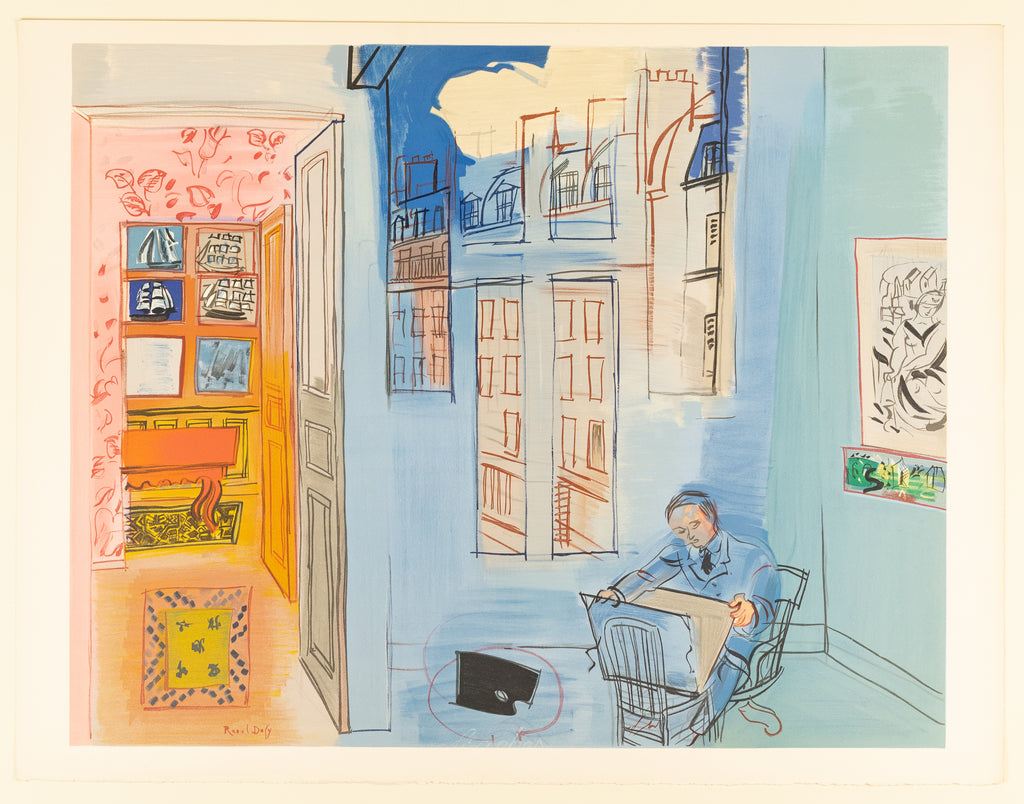Raoul Dufy (1877-1953)(after)
PIERRE LÉVY COLLECTION
NAME: L’atelier de Impasse Guelma
ENGLISH NAME: The Impasse Guelma Workshop
MEDIUM: Lithography on Arches paper
SIGNATURE: Signed in Plate
SIZE: 20 in x 26 in ( (50.8 cm x 66.04 cm)
IMAGE is ACTUAL WORK
Please contact us to request further information or additional images.
(translated from the Pierre Levy collection)
The Impasse Guelma Workshop
Of all the workshops that Raoul Dufy occupied, that of Impasse Guelma, in Montmartre, is certainly the most significant and the most moving. The artist settled there in 1911 and kept it always, even though his absences were long and he did not foresee the time of his return.
From the previous studio, rue Séguier, Dufy bequeathed us some memories: duex or three paintings painted around 1909 under the influence of Cézanne and Cubism and in which the local is hardly discernible behind the deformation desired by the style.
At the other end of the chain, the Perpignan workshop, bathed in a blond southern light, testifies to a perfectly accomplished art, summarizing the research of a lifetime and giving the key to the steps taken.
But it is in the studio of Impasse Guelma that these stages took place and that the painter affirmed day after day, his pictorial way of being. It was there that, returning from his successive trips to Deauville, in England, on the French Riviera, in Italy and in Morocco, then, late in the day, in the United States, he recovered himself, put his order in order. his ideas and took stock of everything he had just gathered. Sometimes he closed his door; "Monsieur Dufy is absent" could be read on a cardboard pinned to the said door and while voices were heard inside. But there was nothing more to do but go back down.
Most often the painter was welcoming and all those who approached the artist keep an indelible memory of this cerulean island where the most civilized man in the world lived and worked. His brazen laugh echoed there superbly. The walls of the studio were painted, in fact, in an azure blue that was later called and somewhat summarily the Dufy blue and on which sang his paintings, his very simple and functional light furniture, and as soon as Spring came, a large bouquet of anemones installed on the table covered with sketches near the window.
Dufy immortalized his workshop on several occasions and through the testimonies of this workplace we could follow his pictorial route for a time. Through the large window with three openings, depending on the search for the moment or the light of day, the house opposite seemed closer or more distant, as did the white cloud which often covered it.
The large Atelier belonging to the Pierre Lévy collection is one of the four versions that we know where there is no nude model. The three sutres belong respectively to the Museum of Modern Art of the City of Paris, to La Phillips' Collection in Washington and to Mr. Pierre Bérès, in Paris. The last two include in their composition a painting of nude, on an easel.
The painting reproduced here is bathed in a transparent and studious blue atmosphere. Nothing screams. We hardly pay attention to the discreet little amateur who has taken refuge in the corner of the room, so much does he blend in with the general blue. Well installed in this banal armchair that Dufy has casually pitched, he is very small, immersed as he is in the surprises of his drawing board. Perhaps Dufy forgot it while working and while painting, on the left, the primer of the private apartment, less severe where the pink accentuated by the patterned wall paper and that of the small area rug, provide the contrast and warmth necessary for the entire work.
On the right, on the wall, a large black and white lithograph of La Baigneuse de Sainte-Adresse and below, one of those small paintings in length that the painter was fond of and where we can see the town's bandstand. d'Hyères, painted so many times by him.
The lithograph will be shipped in a cardboard tube with insurance.
Any condition statement is given as a courtesy to a client, is an opinion and should not be treated as a statement of fact and Singerie, Ltd shall have no responsibility for any error or omission. Please contact us to request further information or additional images that may be available.



